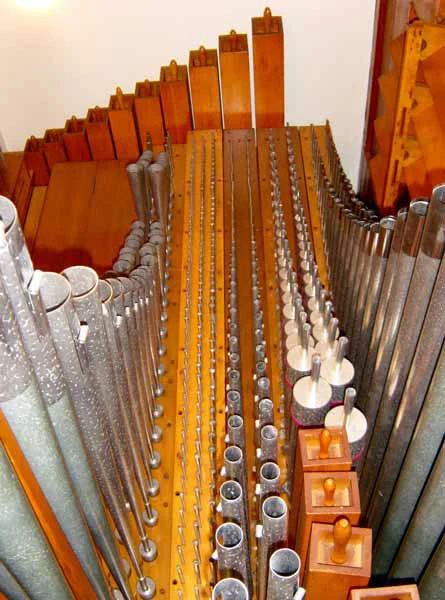Ashburn Chapel at Brooks School
North Andover, Massachusetts
Aeolian-Skinner Organ Company, Opus 980, 1938

The Aeolian-Skinner organ in Ashburn Chapel at Brooks School in Andover, MA was built in 1938 and designated by its builder as Opus 980. It is a three-manual instrument of 20 stops and 27 ranks of pipes having electro-pneumatic action. In many respects this instrument does not depart significantly from its builder’s usual practice at that time. The windchests are the normal pitman-style chests developed and perfected by the Skinner and Aeolian-Skinner firm, the console has the typical self-contained combination action in production then, and the pipework is the usual superior quality that made its builder famous.
What does make this organ very special, however, are some details that may not be immediately apparent. The wind-pressures, for example, are lower than might be expected for an instrument of its time. A stoplist of neo-baroque type was developed, the special wish of Chapel Organist Edward W. Flint working in collaboration with G. Donald Harrison of the Aeolian-Skinner firm. The result was an instrument of modest proportions in which every stop must pull its own weight and contribute something to the ensemble. There is no duplexing or unification in the organ; even the Pedal Organ is entirely independent, something that was unusual for its time. Opus 980 was conceived in reaction to the so-called excesses of the instruments built only a decade previously.
Two stops, an 8’ Principal on the Great and a tenor-C 8’ Voix Celeste in the Swell, were left prepared-for at first, and later were installed by the Andover Organ Company. These were included in the restoration of the organ with modifications to their windchests, but a non-functioning and wholly inappropriate Antiphonal Organ, consisting of a unified Principal, Stopped Flute and Trumpet, was deleted in order to return the organ to its original state.
Mention should be made of the console, furnished with every modern convenience available when it was built. Fully provided with reversibles and duplicated toe-studs, it was retained without technological change in the restoration, except for the removal of the added Antiphonal’s electric drawknobs and their related control equipment.
We are pleased to think that, were Messrs. Harrison and Flint to return to Ashburn Chapel, they would be satisfied to find Opus 980 still carrying on as before, its specification, simultaneously forward- and backwards-looking, still serving Brooks School with distinction.





























